Dear lifeatuoft readers (I still feel like I'm writing postcards),

Over Reading Week, I had the opportunity to participate in a Human Biology and Aboriginal Studies student exchange in Belize; ten students coming from different interests and fields of study, one supervising professor and a service learning component that created both tension and teamwork over the eight days we spent in San Jose Succotz and Hopkins. On the second last day, when we stepped into a beach house in Hopkins that the ten of us would be sharing (two males, eight females and one bathroom), one student sarcastically remarked, "It's like stepping into the Real World."
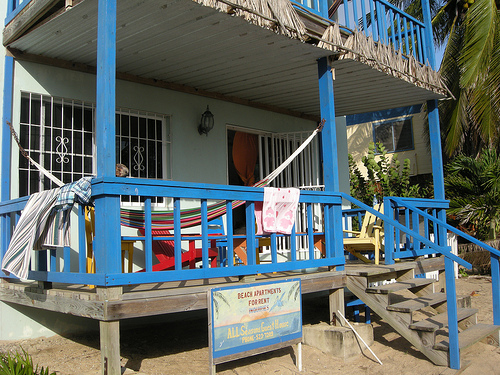
To be honest, most of the tension came from the service learning component of the exchange, not from living in close "Real World" quarters. Students were expected to collect data from local primary and secondary schools and assess how healthy or unhealthy the diet of youth was in the small village of San Jose Succotz. If you aren't familiar with the term "service learning", it's a method of teaching and learning where, after a formal lecture, students participate in community service related to the teachings they received. U of T is now embracing this model that encourages students to think outside of the traditional academic box (and books) and talk to people and build relationships with a specific community.
In San Jose Succotz, students were expected to find out what healthy (local fruits and homemade food) and unhealthy (name brand soda, chips, cookies) foods school children were eating. In Belize, health problems like diabetes, heart and cardiovascular diseases and hypertension due to poor diet is affecting the population. We were told to survey what the children were eating and analyze the garbage we collected in a schoolyard/football field to understand the local youths' diet.
The service learning and research component of our exchange was organized by an outside organization and students immediately felt conflicted by what we were expected to do (enter schools as cultural outsiders, talk to children about food and make judgments based on surveys we didn't create or agree with). The first question I asked the Belize-based organization that headed the exchange was, "Were the parents of children who will be surveyed notified about our presence in the school?" The answer was no and the organizer explained that Belizean research standards were different from those in Canada. Many students, particularly those in Aboriginal Studies, were vocal about how uncomfortable we felt by entering a school with children without parental consent. It just felt wrong. Period. We didn't have criminal background checks before going on the trip (and interacting with children) and in Aboriginal Studies, students must consult with the Ethics Board before interviewing and collecting information from communities. These are strict methodology procedures practiced at U of T that we respect and were not acknowledged during the exchange. Additionally, Indigenous data collection that values oral storytelling and creating a relationship with the "subjects" was usurped by quantitative research methods. The result was a division between some of the Human Biology and Aboriginal Studies students which wasn't uncomfortable but noticeable.
Personally, I felt uncomfortable that we would be making judgments about food and health without having a strong background in nutrition. I was more interested in the cultural aspect of the exchange, particularly learning about different Indigenous communities, relationships between the many ethnic and Indigenous groups and youth empowerment. Although I recognized that a service learning component was part of the trip (we collected garbage like candy wrappers and water and juice sacks from a schoolyard/football field and analyzed the contents), all of the students critiqued how inaccurate the results would be as they would clearly not reflect the diet of the school children (everyone in the village uses the football field that is located in the heart of the village, not just school children).
Despite disagreements in methodology and practices used by the Belizean-based (and North American founded) organization, the experience was eyeopening and I am grateful for being chosen to take part in the exchange. I was mostly proud to be in the presence of passionate students, particularly two who recognized that what we were doing was not only inaccurate but felt wrong and protested about the ethics by not participating in the survey. In terms of learning and self-discovery that I took away from this exchange, I realized that I should listen to my gut more often. If something doesn't feel right, chances are, it's not right.
Of course, there were amazing moments throughout that I'll never forget. We made jewelry out of coke bottle caps with youth leaders, touched and tickled the wooden bars of a Marimba (a musical instrument like a xylophone) that is going to be played in front of Prince Harry next week, played Garifuna hand drums on the porch of the beach house, woke up to roosters at the crack of dawn, watched the sunrise and sunset in Hopkins and most importantly, heard lectures by various community leaders and intellectuals involved in sustainability, Indigenous community building and education and environmental activism.
One of my favourite memories was when our group decided to visit the first lecturer, Maya scholar Dr Filiberto Penados, at his home located on a small mountain of the village. Although he probably wasn't expecting the entire group to visit him, we managed to squeezed onto his porch and listened to him talk about a school he founded that incorporates Indigenous knowledge and practices that helps build its students self esteem and connection to culture.
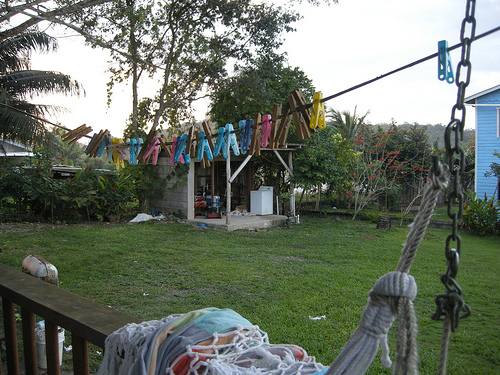
This is Dr. Penados' porch where he gave an impromptu talk about Indigenous learning. It was probably one of the most memorable informal lectures I've heard.
Although I think learning can take place anywhere, leaving a St. George classroom and sitting on a professor's porch in Belize was a treat that I'll never forget. I hope you enjoy some of the snapshots from my learning experience in Belize (I'm not posting images of our field work with children in schools though) and I encourage students to take advantage of student exchanges because you never know what you might learn about a different country and culture, and most importantly, about yourself.
Erin

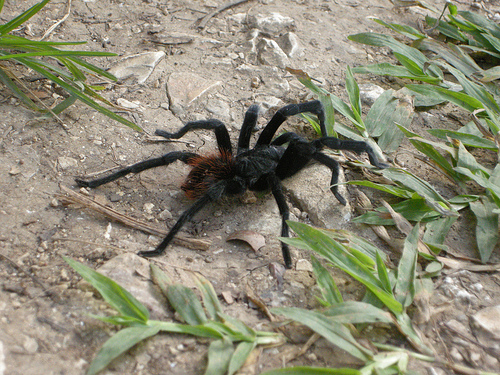
FYI: We didn't stay in a beach house the entire trip but small hostel-like cabins complete with outhouses. Tarantulas were guests in our living spaces.
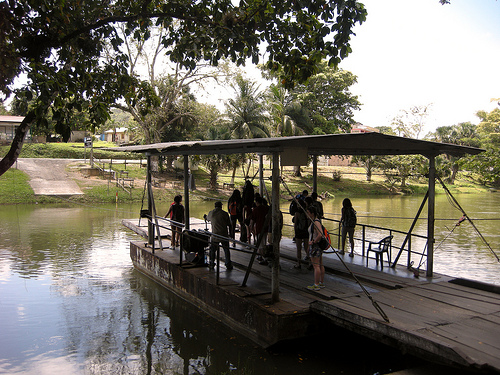
The handcranked ferry ride over the river to Xuanantunich.

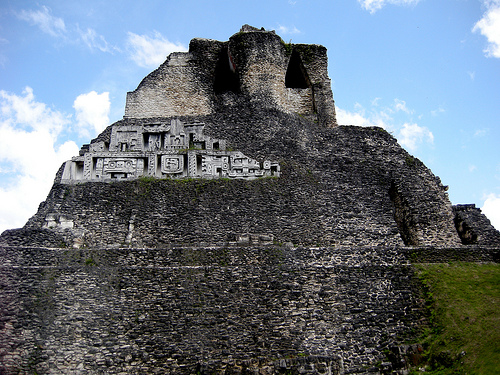
The Maya site Xunantunich.
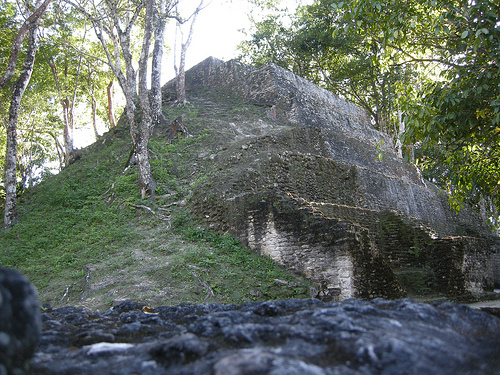
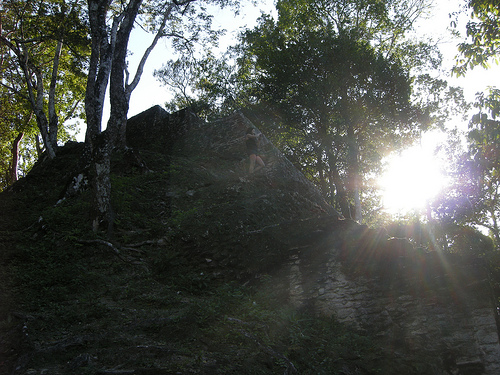
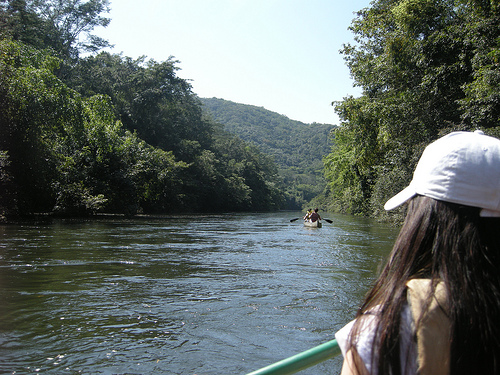
Canoeing down the Macal River. We crashed. Seriously.

A sampling of Belizean dishes.
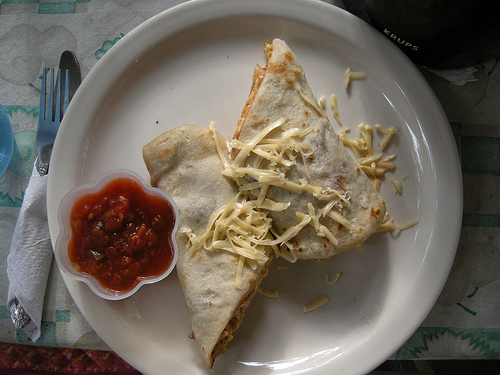
I ate about a dozen burritos over eight days.
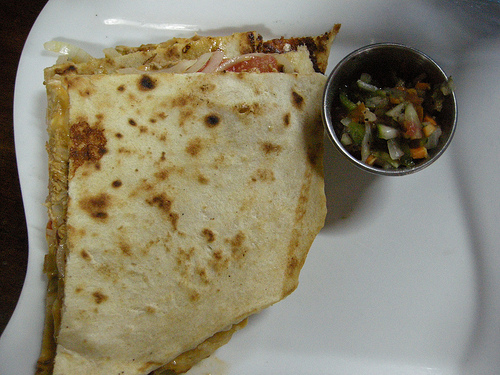
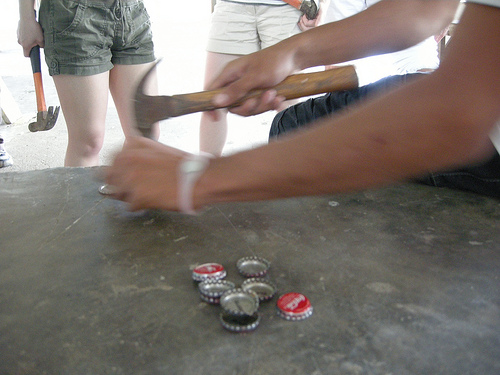
Hammering coke bottle caps to make recycled jewelry with a local community youth leader.
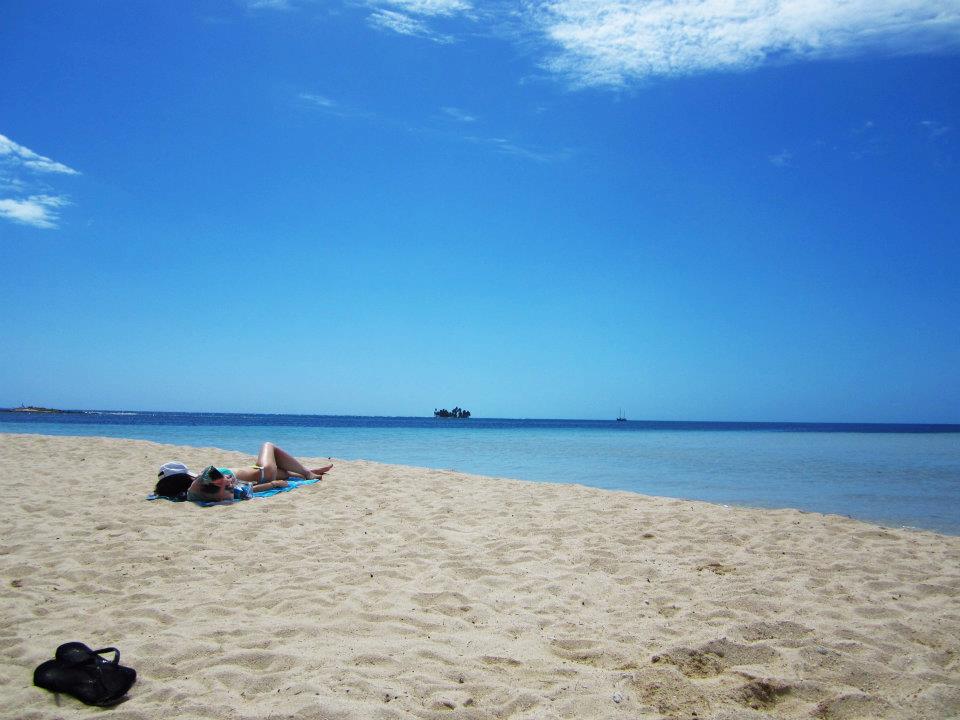
Some much deserve r&r on our second last day in Hopkins. We needed it after six days straight of field work and lectures. And yes, I did get a sunburn on my backside after forgetting to reapply my sunscreen.
 Over Reading Week, I had the opportunity to participate in a Human Biology and Aboriginal Studies student exchange in Belize; ten students coming from different interests and fields of study, one supervising professor and a service learning component that created both tension and teamwork over the eight days we spent in San Jose Succotz and Hopkins. On the second last day, when we stepped into a beach house in Hopkins that the ten of us would be sharing (two males, eight females and one bathroom), one student sarcastically remarked, "It's like stepping into the Real World."
Over Reading Week, I had the opportunity to participate in a Human Biology and Aboriginal Studies student exchange in Belize; ten students coming from different interests and fields of study, one supervising professor and a service learning component that created both tension and teamwork over the eight days we spent in San Jose Succotz and Hopkins. On the second last day, when we stepped into a beach house in Hopkins that the ten of us would be sharing (two males, eight females and one bathroom), one student sarcastically remarked, "It's like stepping into the Real World."
 To be honest, most of the tension came from the service learning component of the exchange, not from living in close "Real World" quarters. Students were expected to collect data from local primary and secondary schools and assess how healthy or unhealthy the diet of youth was in the small village of San Jose Succotz. If you aren't familiar with the term "service learning", it's a method of teaching and learning where, after a formal lecture, students participate in community service related to the teachings they received. U of T is now embracing this model that encourages students to think outside of the traditional academic box (and books) and talk to people and build relationships with a specific community.
In San Jose Succotz, students were expected to find out what healthy (local fruits and homemade food) and unhealthy (name brand soda, chips, cookies) foods school children were eating. In Belize, health problems like diabetes, heart and cardiovascular diseases and hypertension due to poor diet is affecting the population. We were told to survey what the children were eating and analyze the garbage we collected in a schoolyard/football field to understand the local youths' diet.
The service learning and research component of our exchange was organized by an outside organization and students immediately felt conflicted by what we were expected to do (enter schools as cultural outsiders, talk to children about food and make judgments based on surveys we didn't create or agree with). The first question I asked the Belize-based organization that headed the exchange was, "Were the parents of children who will be surveyed notified about our presence in the school?" The answer was no and the organizer explained that Belizean research standards were different from those in Canada. Many students, particularly those in Aboriginal Studies, were vocal about how uncomfortable we felt by entering a school with children without parental consent. It just felt wrong. Period. We didn't have criminal background checks before going on the trip (and interacting with children) and in Aboriginal Studies, students must consult with the Ethics Board before interviewing and collecting information from communities. These are strict methodology procedures practiced at U of T that we respect and were not acknowledged during the exchange. Additionally, Indigenous data collection that values oral storytelling and creating a relationship with the "subjects" was usurped by quantitative research methods. The result was a division between some of the Human Biology and Aboriginal Studies students which wasn't uncomfortable but noticeable.
Personally, I felt uncomfortable that we would be making judgments about food and health without having a strong background in nutrition. I was more interested in the cultural aspect of the exchange, particularly learning about different Indigenous communities, relationships between the many ethnic and Indigenous groups and youth empowerment. Although I recognized that a service learning component was part of the trip (we collected garbage like candy wrappers and water and juice sacks from a schoolyard/football field and analyzed the contents), all of the students critiqued how inaccurate the results would be as they would clearly not reflect the diet of the school children (everyone in the village uses the football field that is located in the heart of the village, not just school children).
Despite disagreements in methodology and practices used by the Belizean-based (and North American founded) organization, the experience was eyeopening and I am grateful for being chosen to take part in the exchange. I was mostly proud to be in the presence of passionate students, particularly two who recognized that what we were doing was not only inaccurate but felt wrong and protested about the ethics by not participating in the survey. In terms of learning and self-discovery that I took away from this exchange, I realized that I should listen to my gut more often. If something doesn't feel right, chances are, it's not right.
Of course, there were amazing moments throughout that I'll never forget. We made jewelry out of coke bottle caps with youth leaders, touched and tickled the wooden bars of a Marimba (a musical instrument like a xylophone) that is going to be played in front of Prince Harry next week, played Garifuna hand drums on the porch of the beach house, woke up to roosters at the crack of dawn, watched the sunrise and sunset in Hopkins and most importantly, heard lectures by various community leaders and intellectuals involved in sustainability, Indigenous community building and education and environmental activism.
One of my favourite memories was when our group decided to visit the first lecturer, Maya scholar Dr Filiberto Penados, at his home located on a small mountain of the village. Although he probably wasn't expecting the entire group to visit him, we managed to squeezed onto his porch and listened to him talk about a school he founded that incorporates Indigenous knowledge and practices that helps build its students self esteem and connection to culture.
To be honest, most of the tension came from the service learning component of the exchange, not from living in close "Real World" quarters. Students were expected to collect data from local primary and secondary schools and assess how healthy or unhealthy the diet of youth was in the small village of San Jose Succotz. If you aren't familiar with the term "service learning", it's a method of teaching and learning where, after a formal lecture, students participate in community service related to the teachings they received. U of T is now embracing this model that encourages students to think outside of the traditional academic box (and books) and talk to people and build relationships with a specific community.
In San Jose Succotz, students were expected to find out what healthy (local fruits and homemade food) and unhealthy (name brand soda, chips, cookies) foods school children were eating. In Belize, health problems like diabetes, heart and cardiovascular diseases and hypertension due to poor diet is affecting the population. We were told to survey what the children were eating and analyze the garbage we collected in a schoolyard/football field to understand the local youths' diet.
The service learning and research component of our exchange was organized by an outside organization and students immediately felt conflicted by what we were expected to do (enter schools as cultural outsiders, talk to children about food and make judgments based on surveys we didn't create or agree with). The first question I asked the Belize-based organization that headed the exchange was, "Were the parents of children who will be surveyed notified about our presence in the school?" The answer was no and the organizer explained that Belizean research standards were different from those in Canada. Many students, particularly those in Aboriginal Studies, were vocal about how uncomfortable we felt by entering a school with children without parental consent. It just felt wrong. Period. We didn't have criminal background checks before going on the trip (and interacting with children) and in Aboriginal Studies, students must consult with the Ethics Board before interviewing and collecting information from communities. These are strict methodology procedures practiced at U of T that we respect and were not acknowledged during the exchange. Additionally, Indigenous data collection that values oral storytelling and creating a relationship with the "subjects" was usurped by quantitative research methods. The result was a division between some of the Human Biology and Aboriginal Studies students which wasn't uncomfortable but noticeable.
Personally, I felt uncomfortable that we would be making judgments about food and health without having a strong background in nutrition. I was more interested in the cultural aspect of the exchange, particularly learning about different Indigenous communities, relationships between the many ethnic and Indigenous groups and youth empowerment. Although I recognized that a service learning component was part of the trip (we collected garbage like candy wrappers and water and juice sacks from a schoolyard/football field and analyzed the contents), all of the students critiqued how inaccurate the results would be as they would clearly not reflect the diet of the school children (everyone in the village uses the football field that is located in the heart of the village, not just school children).
Despite disagreements in methodology and practices used by the Belizean-based (and North American founded) organization, the experience was eyeopening and I am grateful for being chosen to take part in the exchange. I was mostly proud to be in the presence of passionate students, particularly two who recognized that what we were doing was not only inaccurate but felt wrong and protested about the ethics by not participating in the survey. In terms of learning and self-discovery that I took away from this exchange, I realized that I should listen to my gut more often. If something doesn't feel right, chances are, it's not right.
Of course, there were amazing moments throughout that I'll never forget. We made jewelry out of coke bottle caps with youth leaders, touched and tickled the wooden bars of a Marimba (a musical instrument like a xylophone) that is going to be played in front of Prince Harry next week, played Garifuna hand drums on the porch of the beach house, woke up to roosters at the crack of dawn, watched the sunrise and sunset in Hopkins and most importantly, heard lectures by various community leaders and intellectuals involved in sustainability, Indigenous community building and education and environmental activism.
One of my favourite memories was when our group decided to visit the first lecturer, Maya scholar Dr Filiberto Penados, at his home located on a small mountain of the village. Although he probably wasn't expecting the entire group to visit him, we managed to squeezed onto his porch and listened to him talk about a school he founded that incorporates Indigenous knowledge and practices that helps build its students self esteem and connection to culture.
 This is Dr. Penados' porch where he gave an impromptu talk about Indigenous learning. It was probably one of the most memorable informal lectures I've heard.
Although I think learning can take place anywhere, leaving a St. George classroom and sitting on a professor's porch in Belize was a treat that I'll never forget. I hope you enjoy some of the snapshots from my learning experience in Belize (I'm not posting images of our field work with children in schools though) and I encourage students to take advantage of student exchanges because you never know what you might learn about a different country and culture, and most importantly, about yourself.
Erin
This is Dr. Penados' porch where he gave an impromptu talk about Indigenous learning. It was probably one of the most memorable informal lectures I've heard.
Although I think learning can take place anywhere, leaving a St. George classroom and sitting on a professor's porch in Belize was a treat that I'll never forget. I hope you enjoy some of the snapshots from my learning experience in Belize (I'm not posting images of our field work with children in schools though) and I encourage students to take advantage of student exchanges because you never know what you might learn about a different country and culture, and most importantly, about yourself.
Erin

 FYI: We didn't stay in a beach house the entire trip but small hostel-like cabins complete with outhouses. Tarantulas were guests in our living spaces.
FYI: We didn't stay in a beach house the entire trip but small hostel-like cabins complete with outhouses. Tarantulas were guests in our living spaces.
 The handcranked ferry ride over the river to Xuanantunich.
The handcranked ferry ride over the river to Xuanantunich.

 The Maya site Xunantunich.
The Maya site Xunantunich.


 Canoeing down the Macal River. We crashed. Seriously.
Canoeing down the Macal River. We crashed. Seriously.
 A sampling of Belizean dishes.
A sampling of Belizean dishes.
 I ate about a dozen burritos over eight days.
I ate about a dozen burritos over eight days.

 Hammering coke bottle caps to make recycled jewelry with a local community youth leader.
Hammering coke bottle caps to make recycled jewelry with a local community youth leader.
 Some much deserve r&r on our second last day in Hopkins. We needed it after six days straight of field work and lectures. And yes, I did get a sunburn on my backside after forgetting to reapply my sunscreen.
Some much deserve r&r on our second last day in Hopkins. We needed it after six days straight of field work and lectures. And yes, I did get a sunburn on my backside after forgetting to reapply my sunscreen.
I feel like I was there!
Awesome photos! Xunantunich looks so awesome. And those burritos look amazing! Which exchange was this and how did you apply?
Hi Dan and Timmy,
I applied through Aboriginal Studies. It was a joint exchange with Human Biology. Students apply directly to the department who selects participants based on an application. For ABS, students were asked to submit a resume, community work experience, how the exchange might help future graduate work and a statement of interest. The Human Biology students had a different application process and required a reference letter. There are several student exchanges available through different departments over Reading Week. When I went to the safety abroad seminar there were students going to Vietnam, Kenya, Kosovo and Texas (everyone laughed at the last destination).
I CAME FROM THERE!!!

 Just saying.
Just saying. 
just wondering if there were many spiders / tarantulas while you stayed there?